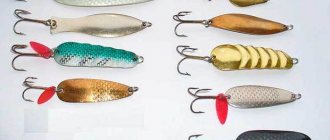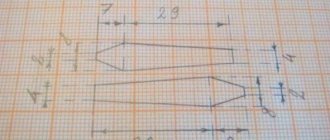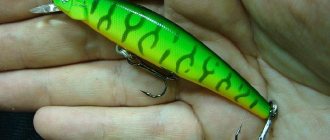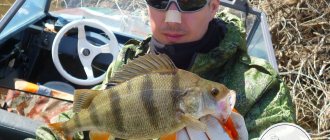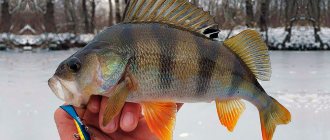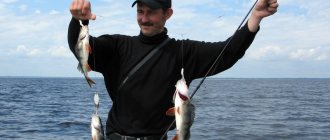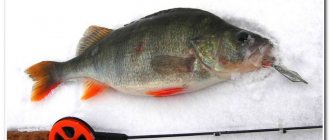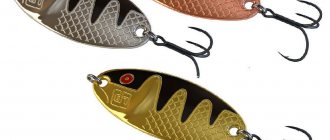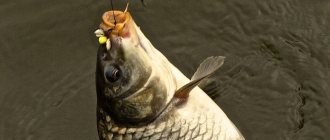Game of vertical perch spoon
Some factors influencing the play of purchased or homemade winter vertical perch spoons are briefly discussed on the previous pages of the topic.
Here, the game on the retrieve of vertical spinners, made for winter vertical perch fishing, can be analyzed in more detail.
The conditions of the game, as well as the tactics of trolling a perch spoon, depend on the configuration of the winter fishing rod, the structure of the bait, the depth of catching perch, the characteristics of the reservoir, but must be entirely subject to our actions, transmitted through the transmission link of the equipment - the fishing line.
The tactics of “playing” (retrieving) your vertical perch spoon can be more clearly illustrated in winter using this virtual example.
To do this, lower the perch bait into a hole at the bottom of the reservoir, where a concentration of measured perch should presumably be located. Suppose it is a flooded bush or snag protruding above a depth of 1.5-2 meters.
Then we will raise the spoon to a height of half a meter and at the next stage of the game we will release the vertical perch homemade product into free gliding. To do this, let’s sharply drop the whip of the winter fishing rod down.
After dropping a vertical winter lure into free gliding on the surface of the water in the hole, a half-meter piece of discarded, loose fishing line will lie, which our winter perch bait can calmly select in its independent game, due to which it will make the lower wiring somewhere away from the vertical, as a result which in a few seconds will end up in the mouth of a voracious perch.
But, if everything was so simple with the game of perch vertical lures, then the industrialists producing fishing lures would have gone bankrupt long ago, and fishermen (also long ago) would have caught all the fish from the reservoirs.
I’m exaggerating a little, of course, but I would suggest that beginners who like to catch perch on vertical games read the material below more carefully. Link to the archive with drawings of perch gliding spoons.
The dimensions and dimensions of the spinner are shown in the figure.
Dimensions of the template to be drawn on sheet material (copper, bronze, silver sheet 0.2-0.4 mm thick)
So, we cut out a strip of metal and mark the contours of the future spinner
We cut the workpiece to length and clamp it in a vice. Using a metal ruler or other flat object, bend the upper part of the workpiece. The bend is done by eye, very slight, checked with a caliper.
We check the amount of bending with a caliper; the gap in the transverse plane of the workpiece should be approximately 1-1.5 mm
Then you can cut the crown according to the previously drawn dimensions.
We process the crown of the spoon with a file or needle file, round the corners, leave a width of approximately 2 mm in the upper part of the spoon, and 1 mm in the lower part where the tee will be attached.
We get a crown like this
We are preparing the material for the eyelets for attaching the fishing line and tee. You can use soft wire of the appropriate diameter, you can bite off the shank of a long hook
I traditionally use sewing pins for this. We service the inside of the crown with POS-60 solder
Solder the ears to the crown
It very often happens that after soldering the ears, during further filling of the crown with solder, it heats up the entire workpiece, and the ears are soldered back, or even worse, fall out of the crown along with the molten solder.
To prevent this from happening, you need to organize heat removal from the crown of the spinner. To do this, you can put it on a large metal object, here you can do anything, you can use weights from scales, corners, a vice, etc. I use a bronze rectangular blank that came to me back in Soviet times.
After soldering the ears and filling the inside of the crown with solder, it is necessary to file again, removing excess solder.
The solder must be removed in such a way that at the top of the spoon the thickness is approximately 2 mm, and towards the bottom the thickness of the spoon should go down to the edges of the crown itself and be approximately 1-1.5 mm. That is, the tail part of the spinner is thicker than the head part. After all the manipulations with a file, the result is a spinner like this:
We equip the head of the spinner with a tee. Possible with a drop
If there are none, then we equip the tee with cambrics, for which we cut off 1-1.5 mm rings from the red and yellow (green) nipple elastic and put them on the tee.
The influence of fishing line on the game of spinners
The fishing line on winter gear has a decisive influence on the retrieve - the play of perch and any other vertical bait.
With the help of a fishing line, the winter spinner is retrieved from the top, after which a pause may be followed by the grip of a pike or the knock of a perch on a vertical bait.
For the next stage of the game on the bottom retrieve, you should correctly select the length of the line release, taking into account the reduction of the perch spinner speed to zero at the end of the retrieve.
We have already discussed two factors influencing the game of a winter vertical spinner line, which I would call useful. But it is necessary to highlight at least two harmful influence factors.
The whole point is that we can control the spinner only through the transmission link of the equipment of any fishing rod - a fishing line that has a constant physical parameter - thickness; and variable size - the length of the descent corresponding to the depth of fishing for perch or other fish.
And it will be very good if, during periods of forced play with a vertical spoon, the fishing line in reservoirs cluttered with foreign inclusions does not touch anything.
Even after retrieving from the top, the fishing line tied to a vertical spoon always ends up in a taut state, albeit slightly bent in an arc. And during the entire period of playing on the bottom line, the perch vertical lure has to constantly pull the tense burden behind it.
And here in the game of any winter vertical spinner for perch, pike perch, pike, two main points can be distinguished. To do this, let's return to our example.
After a piece of discarded fishing line appears on the surface of the hole, a spinner hanging vertically on a winter fishing rod will begin to select a vein, carrying out spatial tracking in the water.
If, for catching perch, an almost straight spinner called a “clove” is tied, then the vertical bait will pick up the slack in the fishing line, almost without deviating from the vertical when playing.
The “stud” and the stretched fishing line pulling behind the perch lure will practically not deviate during the wiring. The influence of water density on the movement of the vein will also be minimal, since the fishing line will slip through the layer of water, roughly speaking, with its cross section.
The game of vertical perch spinners, which are more curved along the length, will be played in a completely different way. The magnitude of their spatial planning in the horizontal plane will be significantly more influenced by the length and thickness of the fishing line.
What does the center of gravity affect?
As practice shows, this parameter is one of the important ones when choosing a catchable lure for perch. After all, its performance will largely depend on what part of the bait it is located in. In general, this parameter is found in several variations:
- From below. The most common type of spinners for perch. With such a center of gravity, the bait falls with different amplitudes, deviating from the axis of the hole.
- In the middle. This type of location of the center of gravity ensures that the bait takes an almost horizontal position when falling.
- Above. This option for the location of the center of gravity is not so common, but the play of spinners in this situation is very interesting and attractive to fish due to the ornate fall of the bait to the bottom. Even the most lethargic perch is provoked into such a game.
Do not forget that, as always, the choice of one or another bait relative to a given parameter is not a panacea. It all depends on the mood of the perch and the reservoir.
Sheer game of perch spoon
Let's analyze the game of a perch or any other vertical spoon and the factors that most interfere with the bait's free gliding in the water.
Obviously, only the dense medium of water and the intensity of its flow will slow down the progress of a vertically gliding bait attached to a fishing line. Therefore, all experiments related to the game of perch spoons will be carried out in a reservoir without a current.
To do this, we will select a vertical perch bait from the homemade spinners shown in the photo, taking into account the elasticity of the spring of our nod.
If you do not take into account the perch vertical lure itself, the trajectory of which does not change at all when changing the perch fishing horizon, then such a variable value as the length of the fishing line remains on the tackle. Even during a cycle of only one lower retrieve, its length will be increased by the size of the duration of the planning trajectory of the vertical spoon.
By moving the playing horizon of a vertical perch bait 1 meter deeper, we will lengthen the fishing line by the same amount, thereby increasing the area of its lateral surface. And it may turn out that the perch spoon we have chosen will have a very noticeable reduction in the length of the planning arc of the vertical retrieve, as a result of which the bait will become less attractive to perch.
You can slightly increase the length of the horizontal component of the game by changing the structure of the perch spoon. A feature of most homemade perch and pike-perch spinners is the ability to regulate the length of their lines by bending the longitudinal axis directly on the hole.
That is, we have the opportunity to change the characteristics of the wiring of vertical baits depending on the depth of perch fishing, the strength of the river current, and most importantly, the thickness and length of the fishing lines trailing behind them. But this is also not a way out.
How to choose the desired operating mode for the whip?
First, you need to start testing the bait, that is, find out at what depth your favorite spinner stops working and noticeably pokes you in the hand when it falls vertically down without any hanging. When this limit has been found, it should now become a rule to shorten the upward throws and make them sharper at a certain depth, leaving the game unchanged at shallow depths. But you need to remember that the height of the thrown bait should not exceed the length of the winter spinner, even if it is quite small.
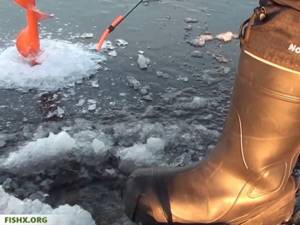
For winter fishing, it is better to choose relatively wide spoons that work the same whether at shallow depths or at deep ones. In addition, summer oscillating spoons are used quite effectively. They are generally insured against unpleasant changes in the game as the depth increases.
Share with your friends!
Perch fishing depth - line thickness
With a noticeable increase in the depth of perch fishing, it is very advisable to replace the bait with a heavier perch vertical spinner of the same structure. Then we will compensate for the resistance of water to movement in a dense environment by the increased descent of the fishing line while its thickness remains unchanged.
Or we catch perch with the same vertical lure, but then we reduce the thickness of the fishing line on the tackle. Why this must be done, let’s look at a clear example.
We pierce a piece of butter with a needle, then drag a thread through it (you can even use a string one). Surely, we will not even feel the resistance of the dense medium. This will be the case with placing a vertical perch spoon called a “carnation” in the water.
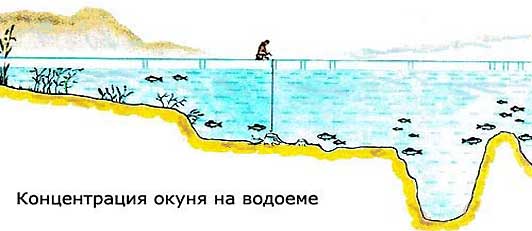
Now let’s cut a piece of the same butter in half with at least a thin thread. Did you feel the difference? When playing a vertical perch spinner on a perch, commensurate resistance will be experienced in the water by the fishing line to which our perch or any other spinner, which is moving far to the side, is attached.
The surface area of the fishing line depends on its thickness and length. Therefore, as the depth of the perch’s position increases, you can simply forget about any intelligible play of any, even the most “catchy” perch spoon.
Then we are left (to the delight of bait manufacturers) with only two options for correctly setting up the gear. To catch perch at greater depths, get a fishing rod with a heavier, but the same structure perch lure tied to a fishing line of the same thickness.
This replacement increases the power of the vertical spoon with the same energy losses caused by guiding a longer line through the water column.
Or take a chance with your perch lure and use it to catch a half-kilogram perch using a web-like vein. Then the length of the lower wire during the game cycle of the perch bait should also remain approximately the same.
But maybe you shouldn’t split hairs by changing gear every now and then. Let’s put a fairly strong fishing line of reasonable thickness on the perch fishing rod, and we will change only perch lures, depending on the depth of the fishing. At the same time, we’ll let the striped little thing grow up, which won’t be very tempted by the wiring of our not-so-small vertical spoon.
You just have to remember one rule. If the performance of a vertical spoon-bait for catching perch is tested in a bathtub with an “excellent” rating, this does not mean at all that the trajectory of its movement will not noticeably change when the perch is trolled already at a depth of 2 meters.
Next, you can figure out which perch lures are best suited for vertical play.
The game of a vertically falling perch spoon
Two homemade spoons for catching perch on vertical lines are shown in the photograph. Nearby are drawn the paths of play in the process of planning winter baits with the same thickness of fishing lines.
Let's look at how both spinners with completely different trajectories of vertical wiring will behave at different depths when fishing for perch.
On the left in the photo there is an almost straight vertical bait for winter lure of perch called “carnation”. A feature of her game is the almost vertical wiring.
If you throw a “nail” spinner into a place where a perch accumulates, then the vertical bait, even with a small weight in the water, thanks to its narrow straight shape, will gain a good initial speed with an almost straight vertical game during the gliding process.
The fishing line trailing behind the perch spoon will track the slide (essentially a vertical drop with a small deviation of the perch spoon to the side) mainly by its cross section.
Therefore, to catch a large perch somewhere in a snag, a bait with a clearly defined vertical line can be tied to a thicker fishing line. A winter fishing rod should have a hard nod.
The thickness of the fishing line has a much greater impact on the performance of the perch gliding lure.
Winter Fishing with Lures: Features of Tackle
Take a closer look at the actions of an experienced winter fisherman: not only does he have a perfectly tuned tackle, but also the action of the spinner is impeccably selected, the fisherman does not fuss and, when necessary, changes the bait, the pace of the spinner, etc.
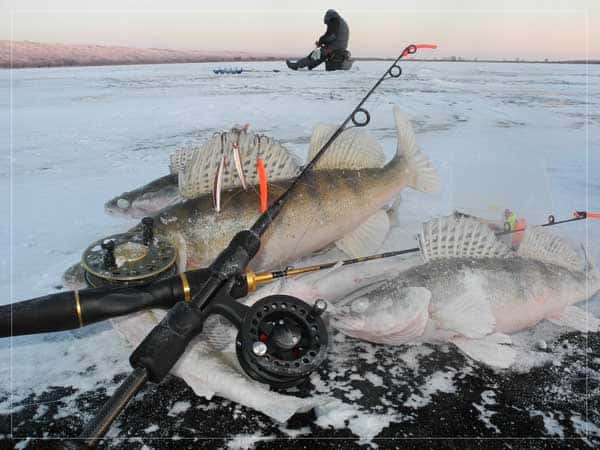
There are many designs of fishing rods for winter trolling, and they can be made from a wide variety of materials; more and more often you can find rods made of nylon and other materials, including vinyl plastic.
A very convenient prefabricated fishing rod, on the handle of which a small reel is attached, and the whip, after disassembling the tackle, is hidden in the handle.
When fishing, a special nod is installed on the tip of the rod, with the help of which you can see every, even slight, touch of the fish to the bait and hook it in a timely manner.
